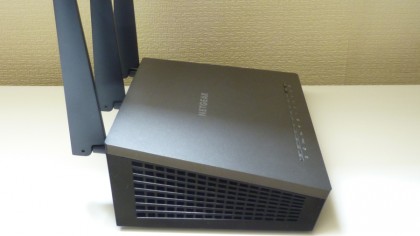Why you can trust TechRadar
When I first ventured into the Netgear R7000's software interface, the basic design and sparse white appearance made me immediately think of the poor software used on the bog-standard routers that used to be given away by ISPs ten years ago. It doesn't look like much, the menus are fairly basic, and there's a minimal amount of graphics used. It's no patch on the rich visual design used on the Linksys EA6900, for example.

But unlike the software used on those aforementioned slow, ugly and cheap plastic boxes that are best forgotten, the R7000's software is perfectly adequate. The front page presents a set of widgets which provide a quick overview of your internet connection status, wireless password, connected devices, parental controls, USB storage and your guest network.

Click on the advanced tab and a lot more detail is provided about the router, such as DHCP status, IP addresses, wireless channels and so on.
There's a fairly standard setup wizard, and as with most other modern high-end routers, the R7000 works perfectly well if you already have another DHCP server on your network. It cleverly switches to a 172.* IP address to avoid conflicts with the usual 192.* address that routers hand out by default.
Live parental controls are configured via a combination of router settings and a Mac or Windows software client download, and are offered for free since they're based on OpenDNS. This is notable because with some routers you have to pay after a certain time, or for more comprehensive coverage.

Tools such as port forwarding, dynamic DNS, IPv6 settings, VPN and a basic traffic meter are found under the Advanced Setup tab. USB storage can be configured for FTP access, or as a network share.
Wireless setup allows changing wireless speeds and channel, but not between 20/40/80 MHz frequencies. If you don't yet have a laptop that can handle 802.11ac, the 5GHz frequency can be used for 802.11n.
Sign up to the TechRadar Pro newsletter to get all the top news, opinion, features and guidance your business needs to succeed!
Wireless performance
I tested the Netgear R7000 using a 2013 MacBook Pro on both 5GHz 802.11ac and 2.4GHz 802.11n at one metre and 10 metre distances.

At 10 metres, my test laptop was in the garden, with clear line of sight to the router. To shake things up a bit, I also tested performance upstairs at the far end of the house, with a thick wall and floor in between, which is more indicative of real-world use.
A crucial factor in 802.11ac performance is the number of streams your wireless client can handle. Most laptops come with 2x2 wireless adaptors. Each stream can manage 433 Mb/s, so even with a 3x3 router, you'll be limited to a theoretical maximum of 866 Mb/s. Hence the reason for using a MacBook Pro, as the 2013 version has 3x3 wireless, unlike Apple's MacBook Air, or the majority of PC laptops, although I expect this will change soon.

The short range 802.11ac results were astoundingly good. A peak transfer rate of 71MB/s is up there with the best 802.11ac routers on the market. Although this drops off quite heavily at range, down to 23MB/s at 10 metres, and 11MB/s in a far room, these speeds are comparable with other routers on the market. Crucially, they're more than enough for streaming HD video.
On 802.11n it's equally promising. 20MB/s is really excellent for 2.4GHz wireless at short range, and the Netgear R7000 maintained a steady 9MB/s at the far end of the house.
While that's quite a drop off, other routers have barely managed 3MB/s in an identical test, so expect perfectly good long-range performance from the Netgear R7000.
